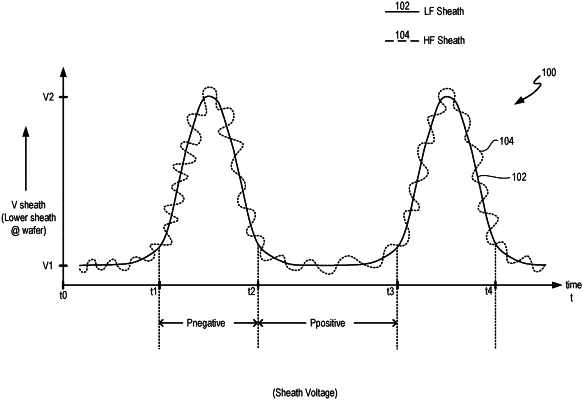| CPC H01J 37/32183 (2013.01) [H01J 37/32146 (2013.01); H01J 37/32926 (2013.01); H01J 2237/24564 (2013.01); H01J 2237/3343 (2013.01)] | 22 Claims |

|
1. A method for achieving uniformity in an etch rate for processing a substrate, comprising:
receiving a voltage signal from an output of an impedance matching circuit;
determining, for each cycle of the voltage signal, a positive crossing and a negative crossing of the voltage signal received from the output of the impedance matching circuit, wherein the negative crossing of each cycle is consecutive to the positive crossing of the cycle;
dividing a time interval of each cycle of the voltage signal into a plurality of bins; and
for one or more of the plurality of bins associated with the positive crossing and one or more of the plurality of bins associated with the negative crossing, adjusting a frequency of a radio frequency generator to output an adjusted frequency value, wherein said adjusting the frequency of the radio frequency generator includes controlling the radio frequency generator to modify the frequency of a radio frequency signal generated by the radio frequency generator, wherein the frequency of the radio frequency signal is modified based on the adjusted frequency value to achieve the uniformity in the etch rate.
|
|
6. A method for achieving uniformity in an etch rate for processing a substrate, comprising:
receiving a voltage signal from an output of an impedance matching circuit;
determining, for each cycle of the voltage signal, a positive crossing and a negative crossing of the voltage signal received from the output of the impedance matching circuit, wherein the negative crossing of each cycle is consecutive to the positive crossing of the cycle;
dividing a time interval starting from a time proximate to the positive crossing and ending at a time proximate to the negative crossing of each cycle of the voltage signal into a plurality of bins;
for one or more of the plurality of bins, adjusting a frequency of a first radio frequency generator to output an adjusted frequency value, wherein said adjusting the frequency of the first radio frequency generator includes controlling the first radio frequency generator to modify the frequency of a radio frequency signal generated by the first radio frequency generator, wherein the frequency of the radio frequency signal is modified based on the adjusted frequency value to achieve the uniformity in the etch rate.
|
|
18. A controller for achieving uniformity in an etch rate for processing a substrate, comprising:
a processor configured to:
receive a voltage signal from an output of an impedance matching circuit;
determine, for each cycle of the voltage signal, a positive crossing and a negative crossing of the voltage signal received from the output of the impedance matching circuit, wherein the negative crossing of each cycle is consecutive to the positive crossing of the cycle;
divide a time interval starting from a time proximate to the positive crossing and ending at a time proximate to the negative crossing of each cycle of the voltage signal into a plurality of bins;
for one or more of the plurality of bins, adjust a frequency of a radio frequency generator to output an adjusted frequency value,
wherein to adjust the frequency of the radio frequency generator, the processor is configured to control the radio frequency generator to modify the frequency of a radio frequency signal generated by the radio frequency generator, wherein the frequency of the radio frequency signal is modified based on the adjusted frequency value to achieve the uniformity in the etch rate; and
a memory device coupled to the processor.
|